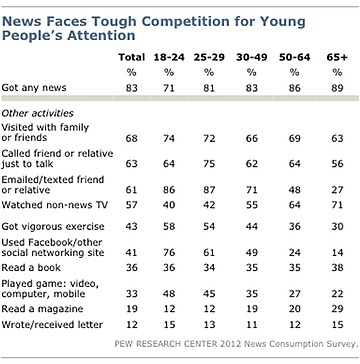 Facebook
Facebook
 X
X
 Instagram
Instagram
 TikTok
TikTok
 Youtube
Youtube

Increasingly, American newspapers are trying to deliver the news electronically: online and by smartphone, tablet, Twitter, e-reader, you name it. But newspapers — particularly large metro dailies — are still having a rough time. Profits diminish or vanish, stocks plunge, bankruptcies abound. Other conventional media, such as television, radio, and magazines, are suffering, too.
Maybe the old media are trying to shove Beethoven down the throats of hip-hop fanatics. That is, young adults most heavily use the electronic forms of communication, but studies show they are less interested in news than older folks. Actually, all age groups are less enthusiastic about news than they once were. Instead of concentrating on the platforms by which news is disseminated, media should perhaps reconsider the concept of news itself.
“In spite of an expanding variety of ways to get news, a sizable minority of young people continues to go newsless on a typical day,” says a study released September 27 by Pew Research Center. In a poll, 29 percent of adults younger than 25 got no news the previous day, either by traditional means (newspapers, TV, radio) or by the digital platforms (online, Twitter, social networking, podcast, etc.). Only 6 percent of those 18 to 24 got news from newspapers; it was a mere 12 percent for those 30 to 39. By contrast, almost half of those above 65 got news via newspapers.
The trend of young people eschewing news has been evident for many years — one reason why newspaper, TV, and radio executives should have foreseen the coming crumbling of their Valhalla. In 1994, the average person age 18 to 29 spent 56 minutes a day on news. This year, that is down to 45 minutes. In 1994, people age 30 to 39 spent 69 minutes a day absorbing news. This year, that’s down to 62.

Significantly, even we older folks are spending less time on the news, according to Pew. In 1994, those 65 and older spent 90 minutes a day on news. That’s down to 83. For those age 50 to 64, daily minutes spent on news dropped from 83 to 76.
It’s possible that the news business has the same problem that…well…Beethoven has. Fifty or a hundred years ago, when classical music impresarios faced a graying audience, they were comforted knowing that as people grew older, they would come to appreciate finer music. That’s no longer true. And that could be happening in the news business. As younger folks get gray, they are not becoming more interested in news. So how can newspapers’ profitability return to halcyon days?
Whether today’s news is too shallow, too titillating, too boring, too sensationalized, too slanted, too objective, too whatever, is a mystery. I get different stories from everyone I speak with. I have long suspected that the conventional journalistic writing style is out of date. In any case, too much executive time is spent pondering the platform and too little time is devoted to studying why people are less interested in news.
The latest Pew survey shows that people care the most, by far, about weather news, followed by crime, community, and sports news. “Papa Doug” Manchester, the new owner of U-T San Diego, and the paper’s chief executive, John Lynch, are stressing the new platforms more than predecessor owners did and going full bore for community and sports news. But as they use their organ as a propaganda vehicle, they may be slashing their own wrists: Pew data show that, overwhelmingly, those getting news by Twitter and social networks don’t want biased coverage.
These days, it’s fashionable for conventional media executives to stress community coverage. After oracle Warren Buffett took a stake in Lee Enterprises, which recently sold the North County Times to Manchester, the community movement intensified. Example: the North County Times was bought for $12 million in September. The next month, the Tampa Tribune was sold for only $9.5 million. Lee is a collection of small papers that got into deep debt and doo-doo trying to buy a big metro daily. Lee emerged from bankruptcy early this year and continues to lose money as revenues decline. (Besides, Buffett isn’t always right. One of his biggest mistakes was putting money into San Diego’s long-gone PS Group.)
A company that completely specializes in community newspapers is beleaguered GateHouse Media. Five years ago, it paid more than $380 million for the money-losing Midwest papers of Copley Press. In the interim, GateHouse stock has plummeted from $18 to below 10 cents as waves of huge losses rolled in.
Still, bullishness on community papers, and community coverage by metro papers, continues. Gordon Borrell, digital advertising analyst, predicts that print ad revenue will grow through 2017. But small and midsize papers will get the gains; advertising in metro papers will still be dropping.
Last year, newspaper print advertising declined for the sixth straight year, according to Pew’s “State of the News Media 2012” report. According to Newspaper Association of America statistics, online advertising rose $207 million last year from 2010. But print advertising was down $2.1 billion. Thus, print losses were more than digital gains by 10 to 1 — worse than the 7-to-1 ratio of 2010.
The picture is not bright this year. On October 25, the New York Times reported that its third quarter advertising revenue was down 9 percent from a year earlier. Digital advertising was down 2.2 percent. Profits plummeted 85 percent, and the stock dropped 22.6 percent on the news.
Advertising sales for McClatchy fell 5.4 percent in the third quarter; online ad revenue rose 2.7 percent. Third quarter profits were cut almost in half. Gannett, the largest newspaper chain in circulation, did better: advertising revenue dropped 6.6 percent in the third quarter, but digital volume rose 5 percent.
Could print ad revenue turn up and digital revenue fulfill its promise? Now that would be news. ■